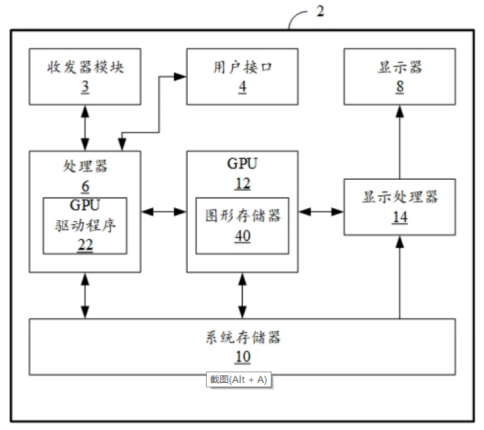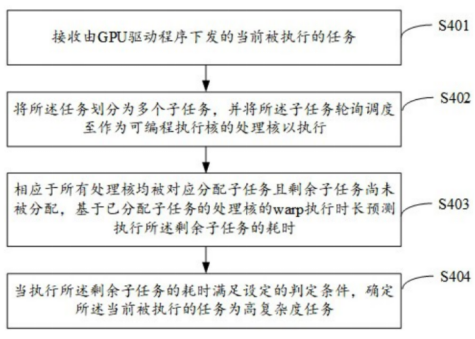GPU chip startup CorePulse Semiconductor recently completed its Pre-A round of financing. The founder of CorePulse said, "Today, CorePulse has achieved independent innovation in core technology links in the field of GPU chip design, and we still insist on making good products down to earth."
At present, when executing tasks issued by the CPU, the graphics processor usually schedules each task to be executed. Since the complexity of each task varies, high-complexity tasks usually occupy more GPU computing resources. For high-complexity tasks, scheduling is used to reduce the GPU computing resource usage and save power. Priority is also something that needs to be considered when scheduling tasks. Although high-priority tasks are more complex, GPU resources will tend to be more inclined to high-priority tasks.
To this end, Xintong Semiconductor applied for an invention patent entitled "Method, device and medium for determining task complexity applied to GPU" on September 6, 2021 (application number: 202111036976.0), and the applicant was Xi'an Xintong Semiconductor Technology Co., Ltd.

Figure 1 Block diagram of computing device
1 is a block diagram of a computing device, which includes: a processor 6, a system memory 10, and a GPU 12. A display processor 14, a transceiver module 3, a user interface 4, and a display 8 may also be included. The transceiver module and the display processor may be part of the same integrated circuit (IC) as the processor and/or GPU. The processor may be a microprocessor, such as a central processing unit (CPU), which is configured to process instructions of a computer program for execution. The processor may include a general or special processor that controls the operation of the computing device. A user may provide input to the computing device to cause the processor to execute one or more software applications. In addition, the processor may also execute a GPU driver 22 that controls the operation of the GPU. The user may provide input to the computing device via one or more input devices.
The GPU performs graphics operations to render one or more graphics primitives to a display. Thus, when one of the software applications executing on the processor requires graphics processing, the processor may provide graphics commands and graphics data to the GPU for rendering to the display. The graphics data may include drawing commands, state information, primitive information, texture information, etc. In some cases, the GPU may have a highly parallel structure built in that provides more efficient processing of complex graphics-related operations than a processor.
Graphics memory 40 may be part of the GPU. Thus, the GPU may read or write data in the graphics memory without using a bus. In other words, the GPU may process data locally using local storage rather than off-chip memory. Such graphics memory may be referred to as on-chip memory. This allows the GPU to operate in a more efficient manner by eliminating the need for the GPU to read and write data via a bus, which may experience heavy bus traffic.

Figure 2 Schematic diagram of the method for determining task complexity applied to GPU
The figure is a flow chart of a method for determining task complexity applied to a GPU, the method comprising: first receiving a currently executed task issued by a GPU driver 22 (S401); then dividing the task into a plurality of subtasks, and polling and scheduling the subtasks to a processing core 300 as a programmable execution core 24 for execution (S402); corresponding to all processing cores 300 being assigned corresponding subtasks and the remaining subtasks not being assigned, predicting the time required to execute the remaining subtasks based on the warp execution time of the processing core 300 to which the subtasks have been assigned (S403); finally, when the time required to execute the remaining subtasks meets the set judgment condition, determining that the currently executed task is a high-complexity task (S404).
In short, CoreTone Semiconductor's patent for determining task complexity in the GPU can determine the task complexity in real time by polling and scheduling subtasks to the processing core as a programmable execution core to execute and predict the task duration, thereby providing a basis for real-time scheduling of GPU computing resources.
CoreTouch Semiconductor is a high-tech enterprise focusing on GPU chip design in the field of graphics and image rendering and high-performance computing. With the vision of "supporting a civilized world with free computing power", it is committed to building an industry-leading GPU chip design platform. In the future, CoreTouch will further promote the implementation of GPU-related application scenarios.
Previous article:With both production capacity and material utilization increasing, Putailai's net profit in 2021 increased by 162% year-on-year
Next article:Japanese media says Apple may reduce iPhone production
Recommended ReadingLatest update time:2024-11-23 11:08


- Popular Resources
- Popular amplifiers
-
 Optimized drivetrain and new semiconductor technologies enable the design of energy-efficient electr
Optimized drivetrain and new semiconductor technologies enable the design of energy-efficient electr -
 Chip Manufacturing: A Practical Tutorial on Semiconductor Process Technology (Sixth Edition)
Chip Manufacturing: A Practical Tutorial on Semiconductor Process Technology (Sixth Edition) -
 TOWARDS CMOS NUCLEAR MAGNETIC RESONANCE SPECTROSCOPY DESIGN, IMPLEMENTATION AND EXPERIMENTAL RESULTS
TOWARDS CMOS NUCLEAR MAGNETIC RESONANCE SPECTROSCOPY DESIGN, IMPLEMENTATION AND EXPERIMENTAL RESULTS -
 RSL10 Environmental Expert Smart Watch
RSL10 Environmental Expert Smart Watch
- iPhone SE 4 reportedly debuts with Apple's self-developed 5G baseband: coming in March next year
- iPhone 17 series revealed to be the first to use 3nm A19 series chips: no chance of TSMC's 2nm process
- The supply chain said that upstream components will be greatly reduced in price: Will domestic mobile phones take the initiative to reduce their prices after the current price increase?
- Apple to spend nearly $100 million to lift Indonesia's iPhone 16 sales ban
- Tata Motors acquires Pegatron's only iPhone factory in India, deepening cooperation with Apple
- Apple faces class action lawsuit from 40 million UK iCloud users, faces $27.6 billion in claims
- Apple and Samsung reportedly failed to develop ultra-thin high-density batteries, iPhone 17 Air and Galaxy S25 Slim phones became thicker
- Micron will appear at the 2024 CIIE, continue to deepen its presence in the Chinese market and lead sustainable development
- Qorvo: Innovative technologies lead the next generation of mobile industry
- Intel promotes AI with multi-dimensional efforts in technology, application, and ecology
- ChinaJoy Qualcomm Snapdragon Theme Pavilion takes you to experience the new changes in digital entertainment in the 5G era
- Infineon's latest generation IGBT technology platform enables precise control of speed and position
- Two test methods for LED lighting life
- Don't Let Lightning Induced Surges Scare You
- Application of brushless motor controller ML4425/4426
- Easy identification of LED power supply quality
- World's first integrated photovoltaic solar system completed in Israel
- Sliding window mean filter for avr microcontroller AD conversion
- What does call mean in the detailed explanation of ABB robot programming instructions?
- STMicroelectronics discloses its 2027-2028 financial model and path to achieve its 2030 goals
- 2024 China Automotive Charging and Battery Swapping Ecosystem Conference held in Taiyuan
- State-owned enterprises team up to invest in solid-state battery giant
- The evolution of electronic and electrical architecture is accelerating
- The first! National Automotive Chip Quality Inspection Center established
- BYD releases self-developed automotive chip using 4nm process, with a running score of up to 1.15 million
- GEODNET launches GEO-PULSE, a car GPS navigation device
- Should Chinese car companies develop their own high-computing chips?
- Infineon and Siemens combine embedded automotive software platform with microcontrollers to provide the necessary functions for next-generation SDVs
- Continental launches invisible biometric sensor display to monitor passengers' vital signs
- South Korea LG 28G Transceiver AiP Antenna 5G Application
- Can the life of a transparent LED display really reach 100,000 hours?
- Infrared radiation in the automotive industry
- Reading Notes on the Good Book "Operational Amplifier Parameter Analysis and LTspice Application Simulation" 02 DC Bias
- Design of Phase-Adjustable RF Active Phase Shifter
- Does anyone know how to initialize the input capture function of GD32?
- EEPROM analysis based on single chip microcomputer
- PCB Image Plane (III) Loop Area and Ground Wire Spacing
- EEWORLD University ---- SPICE teaching video based on Ispice and Hspice (Yuan Ze University)
- Breaking news! Chinese scientists develop the world's largest brain-like computer with the largest number of neurons, with a brain capacity comparable to that of a mouse

 Optimized drivetrain and new semiconductor technologies enable the design of energy-efficient electr
Optimized drivetrain and new semiconductor technologies enable the design of energy-efficient electr RSL10 Environmental Expert Smart Watch
RSL10 Environmental Expert Smart Watch













 京公网安备 11010802033920号
京公网安备 11010802033920号